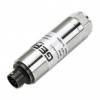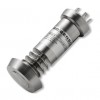Exposed flush face diaphragm pressure sensors with millivolt output signals for measuring the pressures of high viscosity liquids or where the internal volume of the pressure connection needs to be eliminated.
Products
 TPF Flush Diaphragm Strain Gauge Pressure Sensor - Flush diaphragm piezo-resistive pressure sensor for food processing and plastic injection moulding applications with a millivolt output signal in pressure ranges from 10 up to 1000 barg.
TPF Flush Diaphragm Strain Gauge Pressure Sensor - Flush diaphragm piezo-resistive pressure sensor for food processing and plastic injection moulding applications with a millivolt output signal in pressure ranges from 10 up to 1000 barg.



